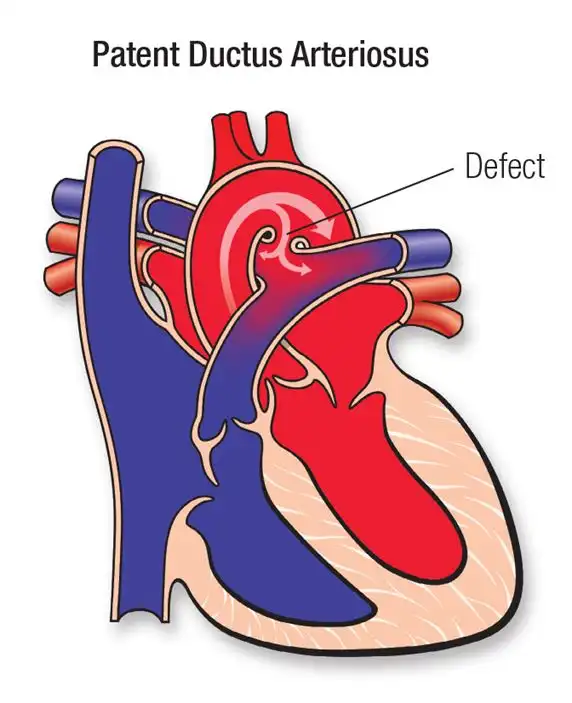Congenital Heart Defects - PDA
Understanding Patent Ductus Arteriosus (PDA)

What is Patent Ductus Arteriosus (PDA)?
A Patent Ductus Arteriosus (PDA) is a congenital heart defect in which the ductus arteriosus, a temporary blood vessel that connects the aorta and pulmonary artery in fetal circulation, fails to close after birth. This can cause oxygen-rich blood to flow back into the lungs instead of being distributed to the rest of the body, potentially leading to complications like pulmonary hypertension and heart strain.
Key Features of PDA
- Congenital condition present from birth
- Occurs when the ductus arteriosus remains open (patent) after birth
- Can vary in size, from small (asymptomatic) to large (symptomatic)
- May lead to increased blood flow to the lungs and heart enlargement
Symptoms of PDA
Symptoms depend on the size of the PDA and may include:
- Fast or labored breathing, especially in infants
- Poor feeding and slow weight gain
- Fatigue and reduced activity levels
- Frequent respiratory infections
- Heart murmur detected during a routine check-up
- In severe cases, signs of heart failure such as swelling and fatigue
Causes and Risk Factors
PDA occurs when the ductus arteriosus fails to close after birth. Risk factors include:
- Premature Birth: More common in premature infants
- Genetic Factors: Family history of congenital heart defects
- Chromosomal Abnormalities: Conditions like Down syndrome
- High Altitude Births: Born in high-altitude regions increases risk
- Maternal Infections: Rubella during pregnancy
How is PDA Diagnosed and Treated?
Diagnosis involves imaging tests to confirm the presence and size of the PDA:
- Echocardiogram: Key diagnostic tool to visualize the PDA
- Chest X-Ray: Shows signs of heart enlargement or pulmonary congestion
- Electrocardiogram (ECG): Detects electrical abnormalities related to PDA
- Cardiac MRI: For detailed imaging in complex cases
Treatment depends on the size and symptoms of the PDA:
- Observation: Small, asymptomatic PDAs may close on their own and require monitoring only.
- Medications: Nonsteroidal anti-inflammatory drugs (NSAIDs) to encourage closure in preterm infants.
- Catheter-Based Closure: A minimally invasive procedure using a device to close the PDA.
- Surgical Ligation: Open surgery to close larger or persistent PDAs.
Risks and Potential Complications
Untreated PDA can lead to complications, such as:
- Pulmonary hypertension (high blood pressure in the lungs)
- Heart failure due to increased heart strain
- Increased risk of endocarditis (heart lining infection)
- Arrhythmias or irregular heartbeats
- Growth delays or failure to thrive in infants
Recovery and Long-Term Management
Recovery from PDA treatment depends on the intervention. Key steps include:
- Close monitoring to ensure the PDA remains closed
- Regular follow-up with a cardiologist to assess heart health
- Gradual resumption of normal activities as advised by a healthcare provider
- Maintaining a healthy diet and lifestyle to support overall heart health
- Taking precautions to prevent endocarditis if necessary
With appropriate treatment, most patients with PDA enjoy a normal, active life.